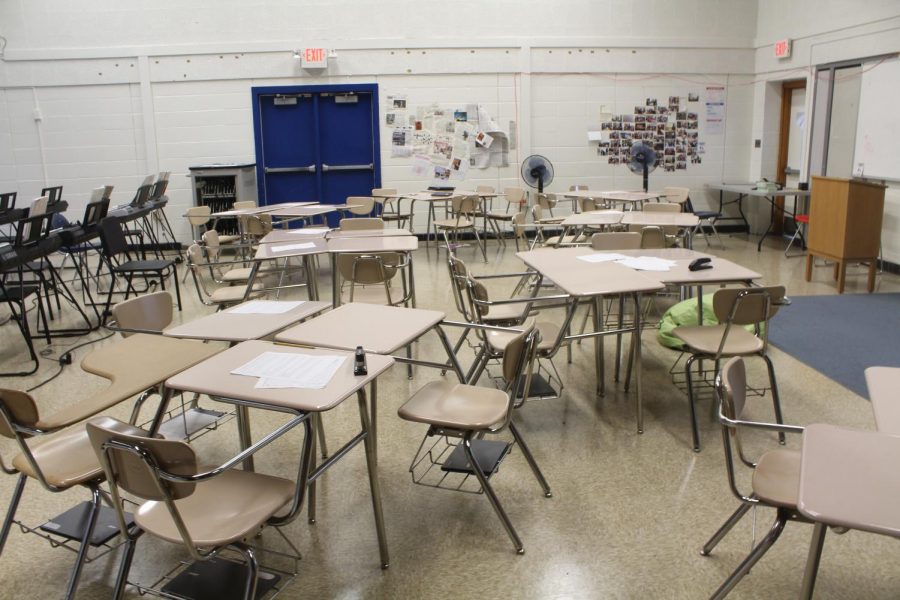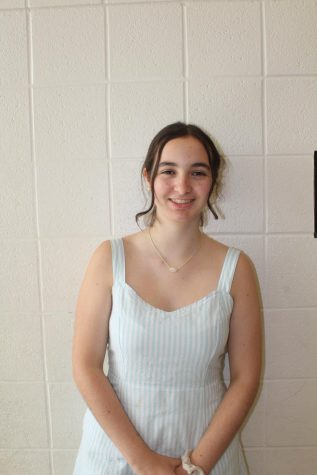Psyched for class: classroom layout and decor engage students
Mr. James’ classroom in the WAUD is organized into clusters. James and other teachers use unique desk layouts to foster different learning environments. Photo by Annabel Redisch.
October 22, 2018
As students settle into their desks, the classroom quickly comes alive with chatter. An otherwise normal room transforms into a gallery as photos, artwork and posters line the walls. Students relax as they talk about the memes on the wall, forgetting the anxious feelings of the first day of school. Perhaps the new school year won’t be so bad after all.
Teachers plan detailed lessons for students every day, but that’s not all they prepare. Many put significant thought into the way they set up their classrooms. Teachers can be as creative as they want to when it comes to classroom layout, and many use both desk formations and decorations to create their desired classroom “vibe.”
The Black & White visited three classrooms to see how different teachers use classroom design to create learning environments of their choosing.
Mr. James
Located in the massive Waud, English teacher Omari James has plenty of room to set up his classroom however he likes. He opts for several small clusters of desks, making the arrangement a comfortable area for students.
While many teachers worry about socializing in class, James sees discussion as beneficial.
“If there are kids that don’t know anybody in the class, then I want to create an environment where they’ll get to know each other,” James said.
Lamps and a sofa along the side establish a relaxed and calm vibe. Posters of memes hang on the walls as well, meant to bring a sense of humor to the classroom, James said.
“Coziness is a big part of what I want to convey in the classroom,” James said. “I figured it could work with the atmosphere I was trying to create because it would just feel a little bit more intimate and friendly.”
Mr. Sonnabend
History teacher Andrew Sonnabend sets up his classroom in a unique U-shaped formation, hoping to facilitate lively class discussions.
“I tend to set my classroom up in a U-shape to focus on the center, so the conversation will not be talking to the back of people’s heads, but hopefully to people who are facing them,” Sonnabend said.
The formation also allows for plenty of space to walk around and steers students away from too much unproductive socializing in class—a potential issue when sitting in clusters.
Sonnabend decorates his classroom with various history-related objects, like a collage of famous world leaders and different flags.
“I want my class to be a room where kids come in and feel like ‘Hey, I’m kind of excited,’” Sonnabend said.
Mr. Rosen
Math teacher David Rosen sticks to the traditional desk setup many picture when thinking of a high school classroom: rows.
“I’ve used other desk formations, and my difficulty with them is that there are times when I’ve gone to work with a specific group and invariably groups behind me either stop working or start talking,” Rosen said.
Over the years, the county has increased the amount of material the math department needs to cover in a year, pushing teachers to be as efficient as possible. For some, including Rosen, this means avoiding group formations that risk getting students off task.
Rosen hangs different math related posters and items around his classroom to inspire students.
¨I put things on the walls of a mathematical nature, applications of mathematics, or interesting mathematical puzzles or problems,” Rosen said. ¨I have a poster of women who were prominent in mathematics, just because I feel like they represent good role models.¨
Going into classrooms with different arrangements every period, many students recognize the amount of effort teachers put into their classrooms. Whether it’s an innovative desk set up or colorful decorations, every detail makes a difference.
“My grandmother was a teacher: going to her school, seeing her getting ready for the next school year, decorating her classroom—she would put in a lot of effort,” senior Breanna McDonald said. “For teachers to take that extra mile means a lot to students.”









